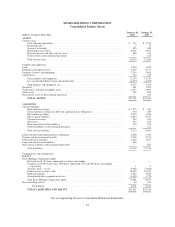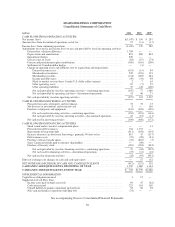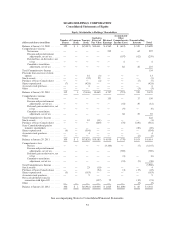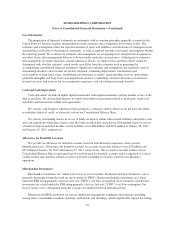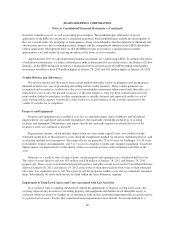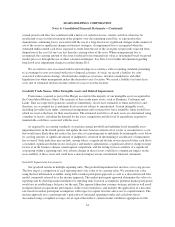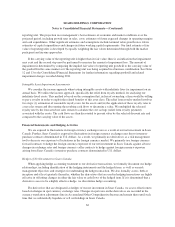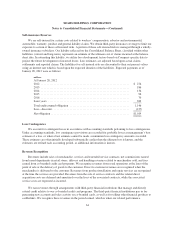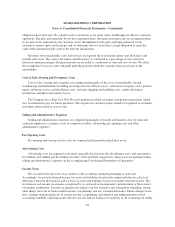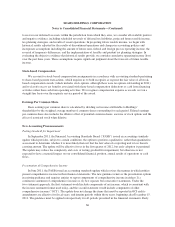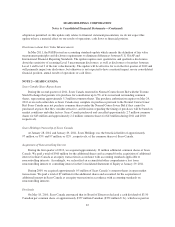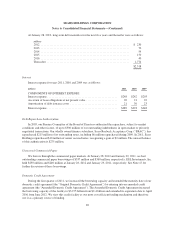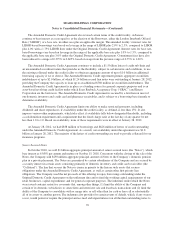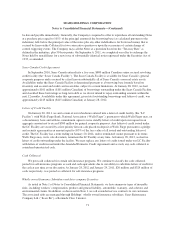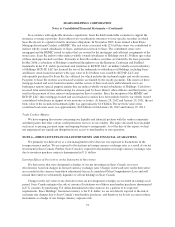Sears 2011 Annual Report Download - page 63
Download and view the complete annual report
Please find page 63 of the 2011 Sears annual report below. You can navigate through the pages in the report by either clicking on the pages listed below, or by using the keyword search tool below to find specific information within the annual report.SEARS HOLDINGS CORPORATION
Notes to Consolidated Financial Statements—(Continued)
Sears Canada Hedges of Merchandise Purchases
Sears Canada mitigates the risk of currency fluctuations on offshore merchandise purchases denominated in
U.S. currency by purchasing U.S. dollar denominated collar contracts for a portion of its expected requirements.
Since Holdings’ functional currency is the U.S. dollar, we are not directly exposed to the risk of exchange rate
changes due to Sears Canada’s merchandise purchases, and therefore we do not account for these instruments as
a hedge of our foreign currency exposure risk. Changes in the fair value of these contracts are recorded in the
Consolidated Statements of Operations as a component of other income (loss) each period.
Hedges of Foreign Currency
The foreign currency forward contracts are recorded on the Consolidated Balance Sheet at fair value and, to
the extent they have been designated and qualify for hedge accounting treatment, an offsetting amount is
recorded as a component of other comprehensive income, net of income tax effects. Changes in the fair value of
those forward contracts for which hedge accounting is not applied are recorded in the Consolidated Statements of
Operations as a component of other income (loss). Certain of our currency forward contracts require collateral to
be posted in the event our liability under such contracts reaches a predetermined threshold. Cash collateral posted
under these contracts is recorded as part of our restricted cash balance.
Counterparty Credit Risk
We actively manage the risk of nonpayment by our derivative counterparties by limiting our exposure to
individual counterparties based on credit ratings, value at risk and maturities. The counterparties to these
instruments are major financial institutions with credit ratings of single-A or better at January 28, 2012 and
January 29, 2011.
Fair Value of Financial Instruments
We determine the fair value of financial instruments in accordance with standards pertaining to fair value
measurements. Such standards define fair value and establish a framework for measuring fair value in GAAP.
Under fair value measurement accounting standards, fair value is considered to be the exchange price in an
orderly transaction between market participants to sell an asset or transfer a liability at the measurement date. We
report the fair value of financial assets and liabilities based on the fair value hierarchy prescribed by accounting
standards for fair value measurements, which prioritizes the inputs to valuation techniques used to measure fair
value into three levels. See Note 4 to the consolidated financial statements for further information regarding our
derivative positions.
Financial instruments that potentially subject Holdings to concentration of credit risk consist principally of
temporary cash investments, accounts receivable and derivative financial instruments. We place our cash and
cash equivalents in investment-grade, short-term instruments with high quality financial institutions and, by
policy, limit the amount of credit exposure in any one financial instrument. We use high credit quality
counterparties to transact our derivative transactions.
Cash and cash equivalents, accounts receivable, merchandise payables, credit facility borrowings and
accrued liabilities are reflected in the Consolidated Balance Sheet at cost, which approximates fair value due to
the short-term nature of these instruments. The fair value of our debt is disclosed in Note 3 to the consolidated
financial statements.
63




